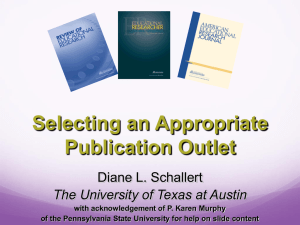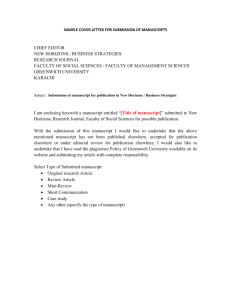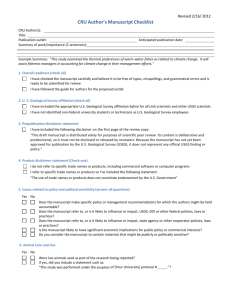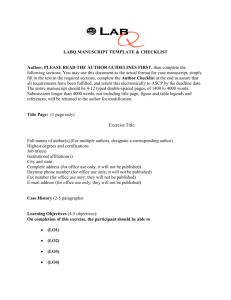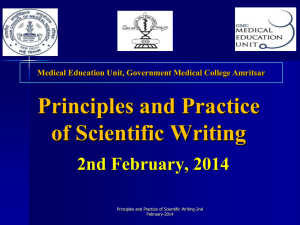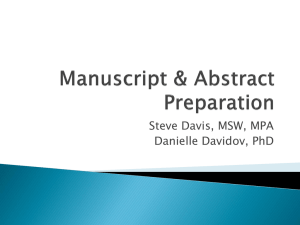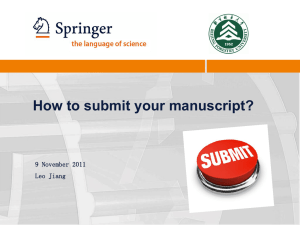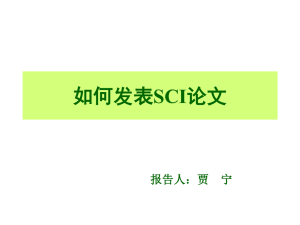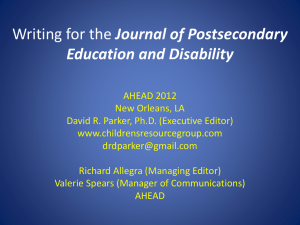Targetting and Selecting Appropriate Journals
advertisement
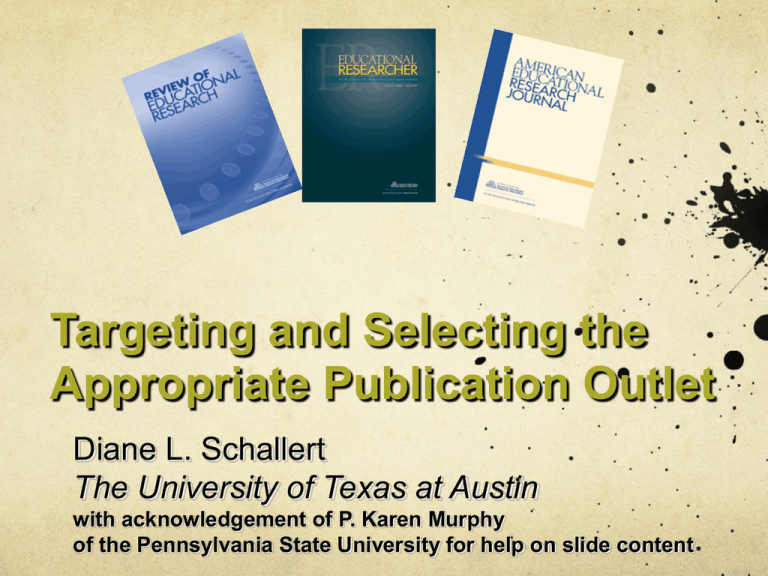
Targeting and Selecting the Appropriate Publication Outlet Diane L. Schallert The University of Texas at Austin with acknowledgement of P. Karen Murphy of the Pennsylvania State University for help on slide content How important is this decision? What are the career benefits for publishing in a particular journal? How important is journal ranking in your tenure and promotion process? Will the data have less impact if they take a long time to publish? How long should you take in deciding on the appropriate journal? Identifying the Possibilities Scan the journals in your literature review or reference list Do a search either electronic or actual thumbing through current hardcopies Reference Guides: Journal Citation Reports Ulrich’s Periodicals Directory Directory of Open Access Journals Cabell’s Directory Selecting Among the Possibilities: A Model (Knight & Steinbach, 2008) Factor 1: Likelihood of Timely Acceptance 1A. Topic centrality 1B. Methodological alignment 1C. Harmony between your manuscript and a journal 1A. Topic Centrality Has the journal published articles on the same subject as your manuscript? If not, has the journal at least published articles on the topics that serve as your theoretical basis? Is your manuscript consistent with the journal’s scope, aim, and editorial statements? AERJ: Standards for Reporting on Empirical Social Science Research in AERA Publications Aim and Scope: e.g., AERJ The American Educational Research Journal has as its purpose to carry original empirical and theoretical studies and analyses in education. The editors seek to publish articles from a wide variety of academic disciplines and substantive fields; they are looking for clear and significant contributions to the understanding and/or improvement of educational processes and outcomes. Manuscripts not appropriate for submission to this journal include essays, reviews, course evaluations, and brief reports of studies to address a narrow question. The Social and Institutional Analysis section of AERJ (AERJ-SIA) publishes scholarly research that addresses significant political, cultural, social, economic, and organizational issues in education. This section publishes research analyzing the broader contextual and organizational factors affecting teaching and learning, the links between those factors and the nature and processes of schooling, and the ways that such "external" domains are conceptualized in research, policy, and practice. The section invites manuscripts that advance the theoretical understandings of the social and institutional contexts of education and that encompass the diverse communities of schooling and educational research to achieve social justice in education. The Social and Institutional Analysis section welcomes research across a wide range of methodological paradigms, including ethnographic, historical, narrative, legal, experimental/quantitative, critical, and interpretive approaches; the section also invites studies that make the nature and uses of educational research itself the subject of social and cultural inquiry. The Teaching, Learning, and Human Development section of AERJ (AERJ-TLHD) publishes research articles that explore the processes and outcomes of teaching, learning, and human development at all educational levels and in both formal and informal settings. This section also welcomes policy research related to teaching, learning, and learning to teach. It publishes articles that represent a wide range of academic disciplines and use a variety of research methods. 1B. Methodological Alignment Does your manuscript conform to the methodological predilections of the journal (e.g., qualitative, quantitative, multiple experiments, review)? Has the journal published articles using your manuscript’s methodology before? Has the journal published methodological guidelines and have you followed them? Methodology: e.g., JXE Guidelines In consideration of contemporary thinking about statistical significance tests, reflected in the 1993 JXE theme issue Guidelines for Contributors 83(Vol. 61, No. 4), authors are encouraged to use the phrase “statistical significance” rather than only “significance” whenever referring to the results of inferential tests. Furthermore, authors are required to report and interpret magnitude-of-effect measures in conjunction with every p-value that is reported (see the Snyder & Lawson article in the 1993 [Vol. 61, No. 4] JXE theme issue on statistical significance testing). 1C. Harmony between your Manuscript and the Journal Is the manuscript consistent with the disciplinary focus of the journal? How many times is the journal cited in your manuscript? Is the typical time from submission to publication sufficiently short for your needs? Review Lags, Revision lags, Copyediting lags, and Backlogs Determining Time to Publication Time to Publication = Review Cycle Time Delay + Publication Time Delay Review Cycle Time Delay = f (x, y, z) Where x = anticipated average review time y = anticipated number of review cycles z = your ability to address the feedback Publication Time Delay = g (p, q) Where p = publisher’s processing time once manuscript is complete q = backlog of finished articles awaiting publication More on Harmony… What is the journal’s acceptance rate? If it is low, is the manuscript appropriate for an announced theme issue where acceptance might be higher? Acceptance rate/rejection rate is a measure of the journal’s competitiveness (see Cabell’s Directory) Does your manuscript conform to the Instructions to Authors (e.g., prose, length, tables, figures, references)? Does manuscript target audience match that of the journal (e.g., national or international)? Harmony Answers: A Few Good Sources Impressions from colleagues Cabell’s Directory Journal editor, editorial board members, or managing editor Journal and/or its web page Factor 2: Predicted Impact of the Published Article The manuscript’s topic and findings and author(s) (YOU) Journal quality Readership and/or availability …and, of course, timeliness in publication 2A. Manuscript itself Is the topic timely? Are the findings interesting? Can they be made interesting? Is it well-written? What cachet do the authors bring? 2B. Journal Quality Is the journal peer-reviewed? Are the journal’s editor, reviewers, and publisher academically respected? Is the journal ranked or rated by your institution? What is the journal’s impact factor (e.g., ISI Journal Citation Reports or SCOPUS)? Impact Factor The impact factor of a journal is calculated based on a two-year period. It is the average number of citations in a year to all papers published in a journal during the two preceding years. 2011 Journal Impact = A/ B A = the number of times articles published in 2009-2010 were cited in indexed journals during 2011 B = the number of "citable items" (usually articles, reviews, proceedings or notes; not editorials and letters-to-theEditor) published in 2009-2010 A convenient way of thinking about it is that a journal that is cited once, on average, for each article published has an IF of 1 in the expression above. 2C. Readership and Availability What is the journal’s circulation (e.g., regional, national, or international)? Is the journal available through the Internet or indexed electronically (e.g., PsychInfo)? Is it an SSCI journal? Is the journal associated with a society or organization (e.g., AERA) that you value? If all else fails… Consider alternate publications Annals of Improbable Research (AIR) “a bi-monthly magazine devoted to scientific humor, in the form of a satirical take on the standard academic journal.” If all else fails… Consider alternate publications Annals of Improbable Research (AIR) Journal of Irreproducible Results (JIR) “is a magazine of science humor…it contains a unique mix of jokes, satire of scientific practice, science cartoons, and discussion of funny but real research.” If all else fails… Consider alternate publications Annals of Improbable Research (AIR) Journal of Irreproducible Results (JIR) Journal of Universal Rejection (JofUR) “The founding principle of JofUR is rejection. Universal rejection. That is to say, all submissions, regardless of quality, will be rejected. [Nevertheless,] here are a number of reasons you may choose to submit to JofUR” (No anxiety about whether it will get accepted, no page fees, you can claim you’ve submitted to the most prestigious journal in terms of acceptance rate, you retain complete rights to your work and may submit to another journal even before our review is complete, decisions are often rendered within hours of submission.) References Impact factor. (2009, March 31). In Wikipedia, The Free Encyclopedia. Retrieved 01:43, April 1, 2009, from http://en.wikipedia.org/w/index.php?title=Impact_factor&oldid=280898895 Knight, L. V., & Steinbach, T. A. (2008). Selecting an appropriate publication outlet: A comprehensive model of journal selection criteria for researchers in a broad range of academic disciplines. International Journal of Doctoral Studies, 3, 59-79. Sarli, B. (2008). Preparing for publication. Bernard Becker Medical Library: Washington University School of Medicine.
